Blog 10
As I Look Back…:

Photo Credits: https://www.pikpng.com/pngvi/hhTbimm_academic-growth-illustration-clipart/
Hello everyone! We did it! We have made it to the end of my weekly blogs. Thank you so much for joining me once more. Hope you had a successful week. Let’s get started! For this week, I will be looking back on my expedition of this course.
In this course, I was able to meet my course expectations. I learned more about different cultures, psychological methods, and research skills. I gained more knowledge on the influence of culture. I enhanced my critical thinking skills. And I learned more about myself. In addition, I achieved the objectives for this course. I was able to become familiar with psychological research and theory relating to culture as an undergraduate student. I also acknowledge and comprehend that cultural diversity and the impact of culture play major roles in people’s lives. I developed a greater understanding and a deeper appreciation for people from other cultures. Lastly, I was able to connect related and unrelated topics within and outside this course.
Over the past few months in this course, I have been consistently eager to learn about cultures, and their impacts. With this in mind, I did not change my attitude towards Cross-Cultural Psychology. Looking back, I know I did the best that I could in this course. If I could take this course over, I would change my social behaviors. I would try to connect with more peers, teaching assistants, and professor.
So, now you may be wondering why I chose a plant as my visual representation. The plant represents my academic growth. With nurture, proper care, and paying attention to its needs, the plant will flourish one day. In other words, if I neglect my academics, my academic growth can wither away. My academic growth has grown in this course as I have established goals and completed them. One skill that I gained was learning how to use and edit my own website. Another skill that I majorly improved in is writing and citing in the APA format, which is a skill I can utilize in my professional life.
Congratulations! You have now made it to the end of my weekly blogs! Thank you for joining me on this journey! As the popular saying goes, “All good things must come to an end” (which is believed to be famously stated by Geoffrey Chaucer). Have fantastic week and enjoy the rest of your semester. As a special send off, I have included the link to the infamous goodbye song, “Until We Meet Again” from Out of the Box. This is Abri G, with my final sign off.
Blog 9
Course Takeaway:
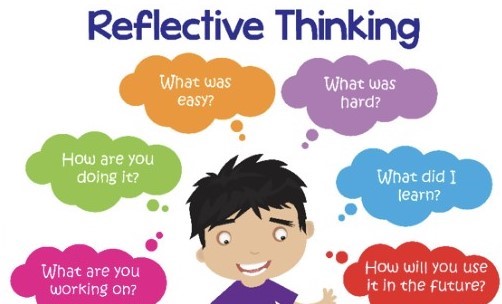
Photo Credits: https://www.teachstarter.com/us/teaching-resource/reflective-thinking-posters-and-cards-us/
Hey you guys! We are almost at the finish line for this course! With that being said, this week’s topic is on course reflection. Hence, why I chose this particular visual representation because it depicts my organizational thought process, as it relates to what I have learned this semester.
So…what did I learn from this course? Was this course about calculating data for a giant technological company? Did I learn about astronomy, the moon, and the stars? Did I learn about chemical components, and how they affect the brain? The answer is NO to all of those questions. This course is literally titled Cross-Cultural Psychology (Psych 420) where I learned different psychological and research approaches in different cultures. I also learned about self and identity and how they can be seen within and across different cultures. I learned quite a few interesting, and thought-provoking concepts. My favorite three topics are intercultural sensitivity stages, nonverbal communication, and gender stereotypes. As you may recall, I covered intercultural sensitivity stages in Assignment Takeaway 2. There I discussed that I identified myself as “acceptance of difference”, and learned about the different stages that one can classify themselves. Nonverbal communication was mentioned in Blog 8, where I learned that people in different cultures relate with each other without the use of words or sounds. For example, some cultures are more expressive with their hands, while others use their eyes to convey messages. I also enjoyed learning about gender stereotypes which was notably found in Assignment Takeaway 4. I learned that gender stereotypes are products of what a society or culture deems as rules or guidelines that everyone should follow as it relates to gender. I also learned that it can be harmful to someone’s identity when they do not conform to gender stereotypes.
Besides learning about numerous topics, I am able to apply what I learned to different topics within this course and apply them to other courses as well. I also noted some similarities of my online portfolio content. For example, Blog 7 and Assignment Takeaway 4 are related because they both share the common theme of gender stereotypes and roles. I talked about gender portrayal in both advertisements and in fairytales. Both are formed by a culture’s perception of what genders should or should not do. They can also have profound impacts on someone’s life, from as early as their childhood. Not only can I apply these topics within this course, I can also apply them across other courses. I have prior knowledge of some of the topics studied in this class, which were mentioned in previous courses such as Communications 112 R (Introduction to Interpersonal Communication). Both courses shared topics such as gender stereotypes and roles, emotions, and several others. Most noteworthy, they shared the Hofstede’s Cultural Dimension Theory, where cultures are categorized based on how they score on various tests like masculinity versus femininity and collectivism versus individualism. In Psych 420, this theory is seen as a psychological approach in understanding cultures. While in Comm 112 R, the theory was mentioned for learning about diversity and how cultures may be different from each other.
I really hope you enjoyed reading this blog! Have a wonderful week ahead! The semester is almost over, so stay tuned to my next and final blog. Thank you for your continuous support. This is Abri G signing off.
Blog 8
Nonverbal Communication:

Photo Credits: https://www.mindfood.com/article/the-17-facial-expressions-that-express-happiness/
Hello! How are you? Hope you are doing great! Welcome back to this week’s blog. The topic of conversation is nonverbal communication. Hence, why I chose this visual representation, because it shows many different facial and body expressions. How good are you at reading someone’s facial expression and body language? Do you have what it takes to be a spy on a covert mission that reads minds and body language, like in the movies? Ok, well maybe not. Nor do I, but with proper training, who knows? Perhaps you may have a gaming face, like a poker face? Or do you have tell-tale signs about yourself? Nonetheless, nonverbal expressions play a vital role in the way we communicate.
I often read people’s facial expressions and body language when I communicate with someone directly in front of me or nearby. I like to people watch and I observe people for curiosity. Often times, I have noticed people from various cultures expressive themselves differently. In some parts of the Caribbean, namely on the island of ST. Thomas, people are very expressive nonverbally. This includes the disapproving look of a parent, a grandmother’s stare, or a father’s hand on the hip. You know that you definitely did something wrong, if you got one of those. On the other hand, if you are on the receiving end of a warm smile, a thumbs up, or even a pat on the back you know that you are receiving approval. I know of these gestures because of first hand-experiences with my own family. Also in my culture, it is appropriate for children to look at their parents and elders in the eyes, whereas this gesture is inappropriate in some cultures. I also realize that other cultures express nonverbal communication differently. They express their feelings through eye, mouth, head, and hand gestures. Some people I know talk with their hands. I am not referring to sign language. Their hand movements convey what they are saying. This helps me understand what they are signaling to me, for example look at that. I remember in high school that some of my peers expressed themselves through their eyebrows. Relaxed eyebrows meant that they were okay, neutral, or calm. While, raised eyebrows meant different expressions like surprised, or intrigued with something.
When I interact with someone new, I do not have any preconceived expectations of their body language or facial expressions. I think everyone is unique and use nonverbal communication in their own way. The more I interact with the person, the more I get familiar with their communication style. For example, when people express themselves nonverbally with their hands, eyes, eyebrows, feet, mouth, and so forth, I do not feel alarmed. Instead I look for cues, as to what message they are trying to convey. I do not expect someone to use specific nonverbal gestures because of their race, ethnic background, or nationality. I have realized that some nonverbal gestures might be individualistic instead of collectivistic.
In addition to different nonverbal communication gestures, I realize that some expressions are a product of universality. For example, when someone places a finger on their lips, they signal to be quiet. Clapping hands can mean that something good happened or that someone is happy. It could also signal “well done” after a performance. Also, not all nonverbal gestures share the same meaning. The same gesture could have a different meaning in another culture. Some expressions could be culture specific and some cultures also have display rules. Display rules tells people of a culture how expressive they should be. As well as when some gestures should or should not be used, based on the social context.
I remind myself to be respectful when someone expresses themselves nonverbally. If I do not understand what they are communicating, I ask questions so the message would be clear. Hope that you enjoyed this blog. This is Abri G signing off! Have a great week!
Blog 7
Fairytales:
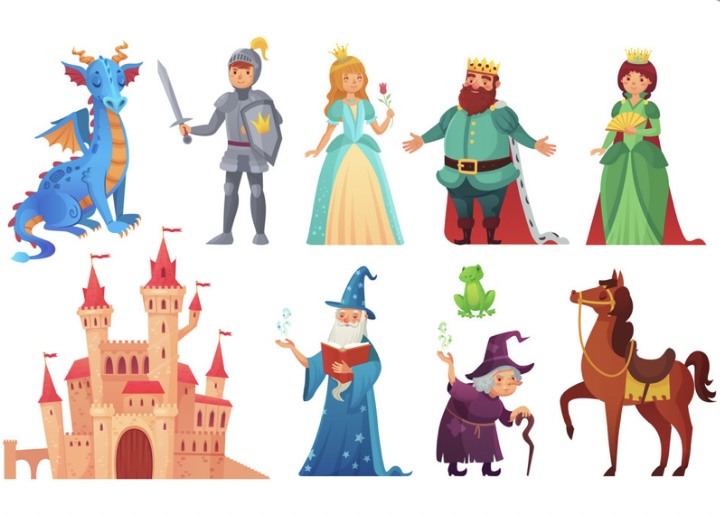
Photo Credits: https://www.vectorstock.com/royalty-free-vector/fairy-tales-characters-fantasy-knight-and-dragon-vector-22498304
Welcome back to my blog! I hope you were eagerly waiting. How was your week? I hope it was good. Can you guess this week’s topic based on the visual representation? The topic is the portrayal of fairytale characters and their impact on reality. Yes, fairytales can come to life when the audience embodies what they see or read in a fairytale. Embodiments can be: acts of kindness, heroism, cruelty, or villainy. What else do fairytales teach us? What can we learn from them?
Fairytales often depict societal norms and trends in their storylines. They reflect a shared set of cultural norms and values. Before, some fairytales were centered on the “damsel in distress” concept. In this concept, a hero (often a man) would save someone (usually a woman) from their doom. Fairytales are now more inclusive in race, ethnicity, and sexual orientation of the cast. Fairytales want their audience to feel as if they too are a part of the story.
The reason why I chose this visual representation is because main characters come in all varieties. They could be humans, animals, robots, etc. Their behavior and what they stand for are equally important too. Young audiences such as kids are very impressionable. They like to copycat and mimic what they see and hear. Main characters who model egalitarian roles could have a positive impact on children. For example, if a main character is kind to animals and gives them respect, a child might want to do the same thing. The child might want to treat the family’s pet better. Or the child might want to be mindful of their interactions with animals. In another example, a main character is seen being helpful and responsible. A child may mimic that trait by helping around the household and assisting in the community. In another instance, a main character is seen interacting with people who are different from them. The main character accepts the person’s differences while treating them with respect and kindness. The main character feels that everyone should be treated equally regardless of their differences. This could encourage children that being different is acceptable.
When I was younger, I was scared of the character Maleficent from Sleeping Beauty. My perception of her changed as I grew older and watched Maleficent the movie. I came to understand that she was misunderstood. She was not the villain as she was portrayed to be. She is the heroine in the latest Maleficent movies. I believe she is a positive influence because she deeply cares about the forest, Aurora, and eventually the people in the kingdom. She also embodies strength, power, confidence, and intelligence.
Hope you enjoyed this week’s blog. Stay tuned for next week’s blog. Have a great week ahead! This is Abri G signing off.
Blog 6
Psychological Needs:

Photo Credits: https://www.dreamstime.com/illustration/cartoon-african-studying.html
Hi guys! Hope you are all doing well. Thank you so much for coming back to my blog. This week’s focus is on the self-determination theory which was explored by Richard M. Ryan and Edward L. Deci in several of their works. This theory states that people share common psychological needs in all cultures. These needs include the desire of autonomy, competence, and relatedness. Each culture expresses and meets these needs differently. Today, I will talk about how I meet each of these needs academically. Let us start with autonomy.
Autonomy refers to one making choices for themselves. It is also connected with the idea of being independent and free from controlling outside factors. I fulfill my need for autonomy by choosing when I want to study and work on my assignments. I select how I want to take my notes whether handwritten or typed. I also decide how much time, effort, and resources I should put into completing my assignments. Most importantly, I determine break and rest times, thus allowing me to be refreshed for my next assignments.
I interpret competence as relating to one’s mastery of a skill or skill set. It also includes learning new skills and practicing them. I satisfy my need for competence by utilizing skills required for virtual learning. For example, I learned to use various virtual meeting applications to communicate with others. Because of this class I am getting better at using the APA writing style. I also became more proficient in creating different types of documents. In addition, I am slowly but surely grasping the program of SPSS Statistics which is used in some of my classes.
Relatedness refers to the social aspect of one’s desire to connect with others. Although we are in a virtual era, I satisfy this need in several ways. I utilize the discussion boards provided by my professors, which allows me to communicate with other students. I have also joined virtual meetings for some of my classes and organizations that I am member of. I am also active in group chats for some organizations, clubs, and classes.
The reason why I chose this visual representation is because this picture is very versatile. The picture shows many possible scenarios that I have mentioned above. The picture may be used to represent myself studying, mastering a skill, or connecting with others.
Now, what are some of your autonomy, competence, and relatedness needs? Are they different or similar to mine? This is Abri G signing off. Have an awesome week!
Blog 5
I am:
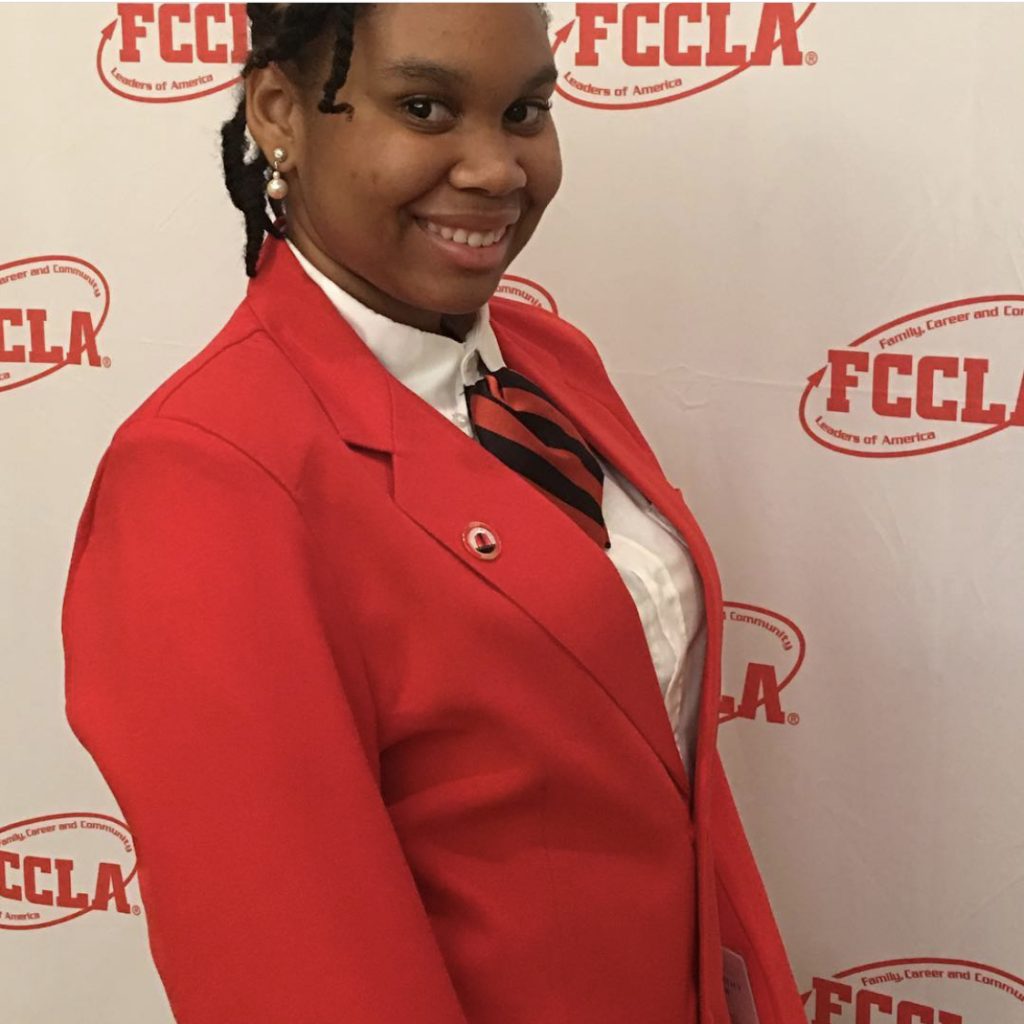
Attending a FCCLA Conference
Hello! How is everyone doing? Did you survive your week? I barely did. Nonetheless, I hope it was productive! Thank you for joining me for this week’s blog! This week’s subject is about our construal selves and how we view ourselves whether independently, interdependently, or perhaps both.
Who are you? How do you view yourself? How many roles do you play in your life? What are some words used to define or describe you? On the other hand, who is Abri Yannah, you might wonder? Well, wonder no more! Read my ten statements below, so you can have a better understanding of who I am.
1. I am…Abri Yannah Graham
2. I am…one of two children
3. I am…loved by my family
4. I am…a loving person
5. I am… leader
6. I am… thoughtful
7. I am… thankful
8. I am… a hard worker
9. I am… a very happy person
10. I am…a student who strives for excellence
Based on my responses, I associate more with independent construal of self than interdependent construal of self. Numbers 1, 4, 5, 6, 7, 8, 9, and 10 are associated with the dimension of independent construal of self.
I am proud to be Abri Yannah Graham. I am a confident young lady who was told from a young age that I can do anything I set out to do. Knowing this, I am very proud of all that I have accomplished thus far in my life. I feel a deep sense of pride in my culture, in my family, and within myself. I appreciate the people that are around me, and I show that appreciation by loving on them. By that I mean doing things, little and small to let them know that I love and appreciate them. I consider myself a leader. I am very fortunate to have been a member in the national student organization Family, Career, and Community Leaders of America (FCCLA). Over the years, it has helped me developed my leadership skills and helped to mold the person I’ve become today. This is the reason I chose this picture as my visual representation.
I am very thoughtful and thankful for the many experiences I’ve had in my life. As a result, I am mindful and considerate of others. Nor do I take other people for granted. I am thoughtful of and thankful for my blessings.
I work hard at everything I do. It does matter if it’s a small task or a huge task, I give it my all every time. To me, it doesn’t make sense to do something part or half way. I take pride in everything I do, so I work hard at everything.
Happy describes me! I love to laugh, tell jokes, and make people around me laugh as well. I smile a lot and you can often hear me giggling! I have read that childhood experiences have a large impact later on in your life. As a young adult, I will have to wait and see the results of this belief in the years to come. Please do not misunderstand me. I am not saying that I am happy every minute of every day, I am saying that I am generally a happy person.
Numbers 2 and 3 are associated with the dimension of interdependent construal of self.
One thing I associate with being interdependent construal of self is the fact that I have a sister. She is my younger sister, and I can’t see myself without seeing her! Yes, we look alike too! She often teases me and say that my iPhone isn’t loyal because it unlocks for her with Face ID! We do almost everything together, as she is my best friend. We talk about anything and argue about everything! When she sings, I am her back up singer, and when I sing she is my back up singer.
I appreciate life and I get to enjoy it with my loving family. My family have endured two category 5 hurricanes, Irma and Maria. Relocation to the United States, and now the pandemic and these negative events in life have brought my family closer. My parents have provided for my sister and I during some extremely difficult times. They have always shown us love through it all, while making the hardships look easy. There is no doubt in my mind, I know that I am loved by my family!
The English proverb Independent construal of self – “Be unique” definitely applies to me. I became independent and unique during the first five years of my life. Before my sister was born, my parents nurtured, guided, and encouraged me to be my unique self. I was allowed to express myself, and to ask questions to include “why such and such”. I remember my mom telling me to use my voice, use a complete sentence, then I would often express myself. When I told them that I did not want to take piano lessons anymore, they said okay. They did not force me to continue the lessons. I was surprised with their reaction, but I later realized that they wanted me to find something that I like to do and stick with it. Whether it’s my sense of humor, my style of dress or my outlook on life, the proverb “Be unique” applies to me.
Now that you have learned much more about me, I challenge you to write your own ten statements about yourself. Determine whether you are most associated with independent or interdependent construal of self. Finally, reflect on your list, you may surprise yourself! This is Abri G signing off. Have a fantastic week! Stay tune for next week’s blog!
Blog 4
It’s Exam Time:
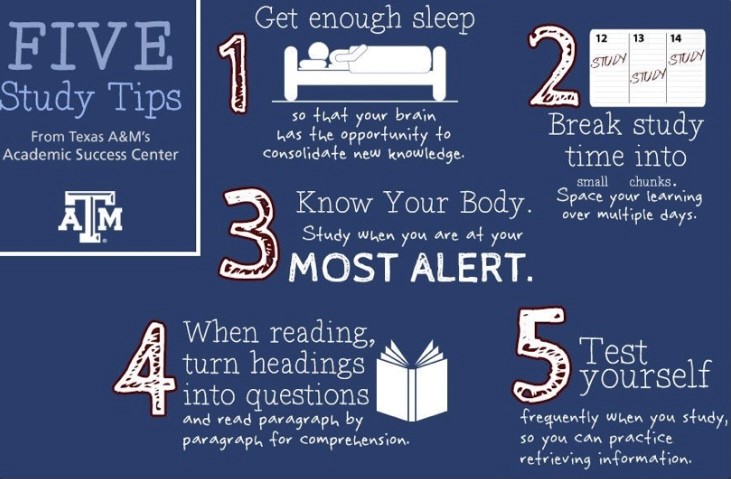
Photo Credits: https://www.pinterest.com/pin/145733737914428992/
Hi everyone, welcome back to my blog! Hope you are doing well and that your week was pleasant. This week’s topic is about exams! Yes, those dreadful, anxiety inducing, clock ticking, brain teasing assessments. Personally, I am not a fan of them, but I prefer them compared to other forms of evaluations. A few days ago, I took my first exam for this class. It covered four chapters that spanned across four modules. I prefer chapter tests, compared to unit tests. I started the test feeling nervous, but soon felt confident because “I’ve got this!” Typically after I take an exam, I would check my score and to see what I got wrong. I do this to gain the knowledge of what the correct responses should have been, thus preparing me for the next time I encounter that particular concept, whether in a conversation or on another test. I recommend doing this after every exam and assessment. When I saw my results, initially I felt pleased, then I reflected on my learning process and how I retained information. I learn best by taking notes of the required materials from lectures, textbooks, as well as through self-interpretation and annotation. I practice this method for all my classes. When provided, I would sometimes view the supplemental information because it helps to clarify the main topics. I would also quiz myself to see if I can apply and remember the information studied. In this particular case, I should have paid more attention to some of the main topics.
Before I take an exam or any evaluation, I utilize and adhere to my test preparation strategy. Hence, this is why I chose this particular picture as my visual representation. It shows some essential test preparation tips provided by Texas A & M’s Academic Success Center. It also mentions some steps that are included in my test preparation strategies which consists of the following:
(1) setting aside study days and study times
(2) when provided, review the study guide or exam review. If not provided with a study guide, I will create my own. Sometimes this step is difficult because I do not know what to include on a study guide. I am still a novice when creating my own study guides. Also, I check to see if the professor or instructor stressed any topics of importance and start from there. I always try to remember, when in doubt, ask about. Reach out to the professor directly but kindly.
(3) If and when needed, seek help
(4) Remember to eat, get rest, and take breaks. I sometimes forget to utilize this step when I should be doing so routinely
(5) Rewrite and organize notes, create flash cards, and T charts
(6) Create and or participate study groups if able to do so
Although these tips are practical and attainable, unfortunately some were not realized because I had limited time to prepare for my exam. Normally, I would do all those things mentioned above and more, but in this case I was unable to do so. I had a full plate and a half with numerous due dates. The time needed to complete one assignments has increased since virtual learning. Honestly, I know I did the best I could on that exam without sticking to my test preparation strategy. When I finally had a break from my other classes, I studied as much as I could within in a short period of time. I do not recommend this method as your first go to means for studying, especially if you have ample time to prepare in advance. Luckily for me, I remembered some topics from previous classes and from my worldly knowledge. Hopefully, on the next exam I will have adequate time to study and prepare.
Reviewing the exam’s results will help me in the future. Since the exam was my first for this class, I now have a better understanding of what type of questions will be asked, and how they would be worded, which will be an integral part of my test preparation. If it is allowed, I would look at each question first, then answer the questions I know first. This would give me more time to focus the questions that I am unsure of. I would also make a mental note of the questions that I am having difficulty with, and spend extra time on those. Most importantly, I would attempt to answer every question and not leave any blank. It is best to make an educated guess, rather than to not try at all.
Remember it is best to give something your all, even if you feel unprepared or unequipped. Also try to manage your time wisely, because time will continue go on with or without you whether you are prepared for assessments or not. You can’t stop time or create it like in the movies and on television shows. Exams are steppingstones to your milestones! Think positive, stay confident, and envision your success because you’ve got this! This is Abri G signing off and I hope you have a wonderful week ahead.
Blog 3
Personality:

Some of My Personality Traits
I created this visual representation because it reflects some key characteristics about my personality. Over the years, my personality has not change much, and it has been constant.
Hey everyone. I hope you all are doing well. This week’s blog is about personality! Do you feel like some people know the real you? Or do you feel like some people do not know you at all? Sometimes, in friendships I feel some people do not actually know me, and I am like, “Hmm…that is weird, or why would they think that”. More importantly, do you truly know yourself? I think it is crucial that one should know their authentic self. I have taking my fair share of personality tests, sometimes for fun and other times as assignments. In this instance, I was tasked in taking a personality assessment titled “Your NEO Summary” by Paul T. Costa, Jr., and Robert R. McCrae. Honestly, this is one of the most consistent tests I have taken that fits my personality. The five areas of this test are neuroticism, extraversion, openness, agreeableness, and conscientiousness. I scored a fifteen for neuroticism which is quite low according to the chart. This means that I am relaxed but still feel secured. I believe this true. For example, when I am under pressure, I usually freak out for a quick minute. Then, I would assess the situation to figure out what is the best course of action. Finally, I would attempt to resolve the problem. Once, I brought all the wrong books to school because the previous day was a “snow day”. Clearly, I did not remember the correct schedule for that day. When I got to school, I panicked after learning that the schedule was going to be different than I thought. Soon after, I calmed down and communicated with my teachers about my situation. Luckily, they were all very understanding which made me feel much better.
Regarding extraversion, I am usually considered an introvert which was reflected in these results. I earned a twenty-six which is incredibly low compared to the standards of this personality test. However, this simply means that I can be reserved and shy. Although, I am reserved, I desire to be around others at times. I prefer being alone or with a few genuine friends. I care more about the quality of the friendship than the quantity of friends. Usually before I talk to someone, I try to figure out what mood they are in, based on the body language or what they are doing. For example, meeting new people is easy for me but making friendships that lasts are slightly more difficult. I do not open up to others unless I feel very comfortable with them. I prefer to be around people who are genuine versus being with a crowd people and not feel a connection between them. Sometimes I feel like I am both an introvert and extrovert, which depends on the environment I am in. In another instance, I attended a convention, and I came out of my shell. I interacted with many people and shared ideas. It felt great to interact with others who share similar interests as me.
For openness, I scored a twenty-eight which is average. I agree with this result. This implies that I am rational but like to try new things. It also indicates that I like a balance between customs and doing things differently. For example, I love music and fashion. I love some classic styles of clothing, while enjoying some new styles and colors. When it comes to music, I am an enthusiast of both old and new school music for some genres. I also enjoy being in the kitchen baking and cooking. For instance, I really wanted to recreate a traditional dish that my grandmother used to make. I took a new updated recipe to recreate the traditional food. Although I enjoy traditional foods, every now and then I like to try a new recipe or new dish.
Finally with shrieks of excitement, I scored high in a category. I gained a thirty-nine which is remarkably high for agreeableness. This means that I am caring, considerate, warm, and collaborative. This result is consistent with my personality. For example, most mornings I would make breakfast for my family while they are attending virtual school or working remotely. Other times, I would frequently check up on my family members and tend to their various needs without being asked.
Last but not least, I scored a thirty-eight in the conscientious category. This means that like being organized as well having standards for myself. It also means that I work hard to achieve my goals. For example, my desk is organized, and I remember which compartment where I placed my stationery items in. Besides my desk, I like to reorganize my dresser and bedroom. I also like creating and achieving goals. For example, submitting assignments before their dates are recurring goals for me. A personal goal for me is to find time to relax. Currently, I am still working towards that goal. In conclusion, I recommend that everyone take this personality test. The results were consistent with my personality; however the results may be inconsistent with your personality. I think it is fun taking personality tests to see how the results compare with your actual personality. I hope you have a wonderful week ahead! This is Abri G signing off.
P.S. I provided the link to the personality test below. Enjoy.
Blog 2
Academic Journey:
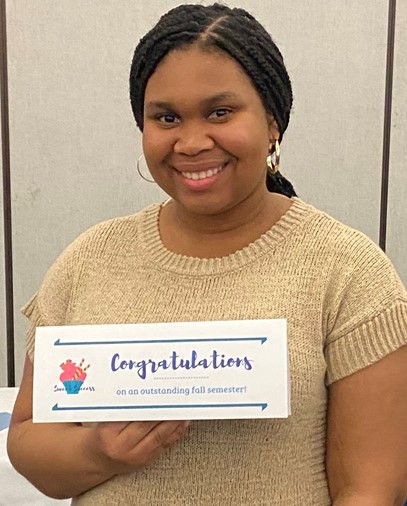
Myself at ODU
This picture was taken when I was a freshman, in my first semester at ODU, which was in the fall of 2019. I chose this picture because it was the first time the Housing and Residence Life committee recognized my academic success. I met the requirement of having at least a 3.4 GPA. First, I received a congratulatory email. Then a received a recognition sticker on my dorm room door, and finally I attended and gained more recognition at a reception in the Webb Center, where this picture was taken. It was all a surreal moment for me!
Some values that are important to me are respect, determination, responsibility, trustworthiness, reliability, and genuineness. All the values mentioned are relevant to my career pursuits. Having these values are beneficial to me personally, for my future career and clients.
My family did not have things handed to them. They worked hard to achieve their goals. They made many sacrifices. For example, my fraternal grandmother did not attend high school, because she had to take care of her younger siblings. My maternal grandparents, migrated from their home country, in search for better opportunities. My grandparents did not have an easy life and they wanted their children to have better life than they had. My parents instilled in me this concept of “doing better than those who came before you”. With this inspiration, I ensured that I did well in everything I did. In high school, I graduated in the top 20 out of roughly 500 students. I studied and worked hard, stayed up late at nights and barely slept. I had little time for recreational activities because school was so time consuming.
I decided to pursue a higher education for several reasons. It was a goal of mine to attend a college or university. As a means to an end, I wanted to attend an institute of higher learning in order to have a better quality of life, which meant having a career, securing a good salary, and so forth. Also I wanted to meet new people, make new connections, have lasting memories, who knows maybe even find love. Ultimately, I want to be able to take care of my family if the need arises. Lastly, I want to help my community and if I ever have kids, I want them to have a better life than me. My academic journey so far has been made possible by the love and support of my family and friends. They have been very supportive and have inspired me to do my best. They are also a constant source of motivation and have guided me in the right direction when needed. They are my rock and my foundation, and I am forever grateful to them.
Wow, this was a very personal blog, and I hoped you enjoyed getting to know a little more about me. I hope you had a great weekend and enjoy a wonderful week ahead! Stay tuned for my next blog. Abri G signing off.
Blog 1
Reflection:

My Notes
Hi, welcome to my first blog. I am so excited to share with you some of my thoughts and expectations of this course!
The course objectives outlined in the syllabus will have an essential impact in the present and in my future. They will enable me in creating correlations from the knowledge learned in this course with worldly experiences. They will also enhance my awareness of self, and people who are different and similar to me. The course objectives will also enhance communication skills gained. In this course, I will be expose to psychological research, which will improve my interpretation skills in the future. Most importantly, I expect to learn more about different cultures, psychological methods, and research skills so I can obtain a more in-depth understanding of them. I am hoping to gain more knowledge on the influence of culture, and to enhance my critical thinking skills which are necessities in today’s society. Finally, I would like to complete self-explorations and insights about myself.
My course goals are attainable as I plan for success. I will accomplish success by studying hard and using time management skills learned. Some things I will do include staying on task with all of my assignments and assessments, and submitting them on time. I will also complete my chapter readings and take good lectures notes. I will reinforce my learning by reading or watching the supplemental materials provided. If by any chance, I do not understand a concept, I will contact my instructor and teaching assistants for guidance. I firmly believe that if I do my best, I will be successful in this course.
I chose a picture of my notes, as my representative visual image. These notes reflect my starting point of my course journey. Currently, I am at the beginning stage and everything is going well. Stay tuned for my next exciting blog. Abri G signing off!